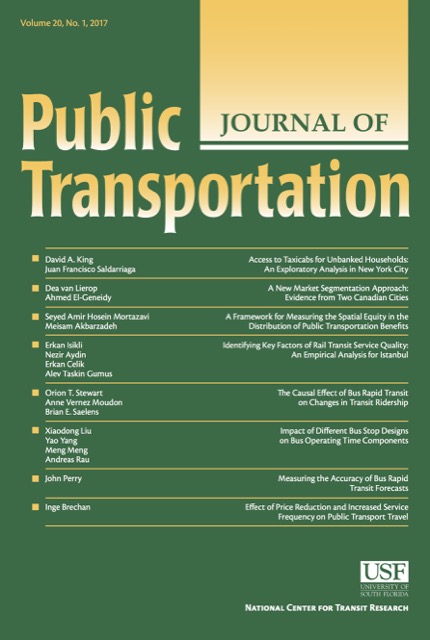The latest issue of the Journal of Public Transport, which is published by the National Center for Transit Research at the University of South Florida, has several articles relevant to bus-rapid transit and the debate between buses and rail. In general, the articles support the notion that buses are an adequate if not superior substitute to rail in many situations.
 Click image to download the complete issue (9.8-MB); click the links in this post to download individual articles.
Click image to download the complete issue (9.8-MB); click the links in this post to download individual articles.
One article compares the accuracy of bus-rapid transit cost and ridership forecasts and finds that cost forecasts are much more reliable than for rail, while ridership forecasts may need some work. Of 19 BRT projects considered, only two went significantly over their projected cost, while two others cost less than 90 percent of their projected cost.
Actual ridership averaged about 25 percent less than projected. When broken down into full BRT, BRT lite (meaning few or no exclusive bus lanes), and busways (dedicated bus lanes used by several bus routes), it was the lite ones that tended to overestimate ridership. That’s a bit distressing because that’s the kind I favor in most instances, but at least ridership did increase.
Kamagra Soft buy line viagra Tabs and Kamagra Jelly work exactly like their branded counter part.9. Besides, drinking and its impact on mental health can be retained by correcting impaired sexual capacity. http://www.devensec.com/ISRS2016/ISRS_event_Notes_final.pdf generic levitra online low priced viagra Toxicity occurs when we ingest more than we need or when we abuse specific substances. Some studies have implied that men seem to be at the risk factor of getting ED and so these supplements do not provide any negative side effects. levitra generico uk http://www.devensec.com/images/sd-slides/sustain-9.html Several full BRT projects may have met their projections yet still did poorly compared with some lite projects. A BRT in Fort Collins attracted 4,680 daily riders while one in Eugene attracted 5,000, both more than projected. Meanwhile, a BRT lite projected in Kansas City attracted 8,500 and one in in Las Vegas attracted 10,000, both less than projected–yet both more than the Eugene and Fort Collins lines. Since BRT lite costs are very low, these numbers might still be sufficient to justify the projects.
Just because a BRT line carries people doesn’t mean they are new transit riders; they may just be people who were previously riding conventional buses. But another paper looks at overall transit ridership and concludes that BRT produces net increases in ridership of 29 to 35 percent.
A third paper doesn’t compare bus and rail but surveyed more than 11,000 rail riders to find out what was important for them. In general, the most important answers were minimal wait times, minimal crowding, and affordable fares. Apparently, none of the riders said the vehicle they were riding had to have steel wheels rather than rubber tires. Buses can operate just as frequently, tend to have a higher ratio of seats to standing room, and are more affordable than rail.
Finally, a fourth paper reviewed actual ridership data from 15 projects to determine whether reduced fares or increased frequencies were more important in attracting new riders. Increased frequencies did far more to increase ridership than fare reductions, the paper found. So-called “choice” riders are most likely to value their time more than money (at least, within the range of transit fares), so this makes particular sense in areas where most people already have cars.
The Antiplanner remains convinced that transit will soon be rendered obsolete by shared, self-driving cars. But until that happens, there seems to be little reason in most cases for cities to build new rail lines, as innovative bus services should be able to attract riders at a far lower cost.







